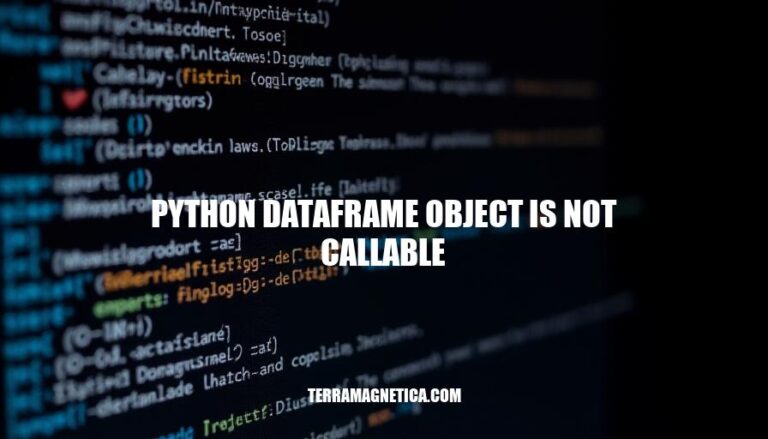


The ‘python dataframe object is not callable’ error is a common pitfall in Python, especially in the realm of data manipulation with libraries like Pandas. This error typically arises when programmers mistakenly treat a DataFrame object as if it were a function, attempting to “call” it with parentheses. For example, using df() instead of accessing it with indexing df[].
Such mistakes can disrupt the flow of data analysis tasks, leading to debugging sessions that interrupt the intended data processing workflow. Understanding the nature of this error is crucial for efficient coding practices in data-centric Python projects.
“‘Python dataframe object is not callable’ signifies that a pandas DataFrame object is being mistakenly treated as a function. This error typically arises when parentheses are used with a DataFrame object instead of square brackets, causing the interpreter to believe that the DataFrame is a callable function.
Common mistakes leading to this error include:
Attempting to access a column or element in a DataFrame using parentheses rather than square brackets.
Misspelling the method names or variables can also contribute to this issue.
Reassigning the DataFrame to a callable function name, which leads to conflicts.
Implications on code execution:
Halts the execution of the script, requiring debugging and correction.
Misinterpretation of intended operations, leading to runtime errors.
Therefore, ensure correct syntactic usage and verification of DataFrame references to prevent this error. Correct usage looks like df['column'] or df.loc[index], not df('column') or df(index).”
Using parentheses instead of square brackets to access a DataFrame column
import pandas as pd
data = {'name': ['John', 'Anna', 'Peter'], 'age': [28, 24, 35]}
df = pd.DataFrame(data)
# Incorrect
age_column = df('age')
# Correct
age_column = df['age']
Treating a DataFrame like a function
import pandas as pd
data = {'A': [1, 2, 3], 'B': [4, 5, 6]}
df = pd.DataFrame(data)
# Incorrect
result = df()
# Correct
result = df
Accidental overwriting of DataFrame variable with a method
import pandas as pd
data = {'x': [1, 2, 3], 'y': [4, 5, 6]}
df = pd.DataFrame(data)
# Incorrect: reassigning df to a method call result
df = df.sort_values(by='x')()
# Correct: only call sort_values
sorted_df = df.sort_values(by='x')
Confusing methods and attributes
import pandas as pd
data = {'city': ['New York', 'Paris', 'Tokyo'], 'population': [8000000, 2148000, 9273000]}
df = pd.DataFrame(data)
# Incorrect: treating columns method as a callable
columns = df.columns()
# Correct
columns = df.columns
Mistyping method names
import pandas as pd
data = {'score': [85, 90, 78]}
df = pd.DataFrame(data)
# Incorrect: typo in method name
result = df.isnulls()
# Correct
result = df.isnull()
Attempting to apply a method on a method call
import pandas as pd
data = {'A': [1, 2, 3], 'B': [4, 5, 6]}
df = pd.DataFrame(data)
# Incorrect: chaining without intermediate variable
df.dropna().drop_duplicates()()
# Correct
no_na_df = df.dropna()
result_df = no_na_df.drop_duplicates()
Prevent such errors by ensuring correct usage of DataFrame access methods and avoiding reassignment of DataFrame objects to other callable results.
Identify the issue: Locate where you’re getting the error. This usually happens when you’re trying to call a DataFrame object as if it were a function.
Check the code: Look for any lines like df(). If df is a DataFrame, it can’t be called as a function.
Review your functions and variables: Ensure no function and DataFrame have the same name to avoid confusion.
Correct the code: If you intended to call a method on the DataFrame, like df.head(), verify it’s written correctly.
Run the script: Execute your script again to see if the error persists.
If fixed, you’re good. If not, double-check similar issues elsewhere in your code.
Check for parentheses misuse: Confirm that you’re not using () unless you’re explicitly calling a method or function.
Test with print statements: Insert print statements before the problematic line to understand the DataFrame’s state.
Update and test: Make the necessary updates and test the script iteratively.
Check for Variable Naming Conflicts: Avoid using variable names that conflict with function names. For instance, don’t name a variable dataframe or df if you later plan to call a method on it.
Verify Parentheses Usage: When accessing a DataFrame column, use square brackets. E.g., df['column_name'] and not df('column_name').
Inspect Function Calls: Ensure you’re calling the DataFrame method correctly.
Methods require parentheses. For example, df.head() instead of df.head.
Review Object Types: Sometimes a function might return a callable instead of a DataFrame. Confirm that you’re working with the right object type.
Code Consistency: Stick to consistent coding practices to avoid unexpected behavior.
If a variable name should hold a DataFrame, ensure it always does.
Unit Testing: Implement unit tests to catch errors early, ensuring all parts of your codebase are interacting correctly.
Type Hints: Use type hints to improve code readability and catch potential errors in IDEs. E.g., def func(df: pd.DataFrame) -> pd.DataFrame.
Code Reviews: Regularly review code with peers to catch mistakes. Fresh eyes can spot errors you might miss.
Documentation and Comments: Clearly document and comment on your code. This can help remind you (and inform others) of the intended use of variables and functions.
Use IDE Autocompletion: Utilize IDE features like autocompletion and linting to avoid common pitfalls and improve code reliability.
Prevention is key; consistently following these guidelines minimizes errors and boosts your code’s efficiency.
The ‘python dataframe object is not callable’ error occurs when a pandas DataFrame object is mistakenly treated as a function, typically due to using parentheses instead of square brackets to access columns or elements. This can disrupt data analysis tasks and lead to debugging sessions.
To resolve this issue, ensure correct syntactic usage and verification of DataFrame references by checking for common mistakes such as: